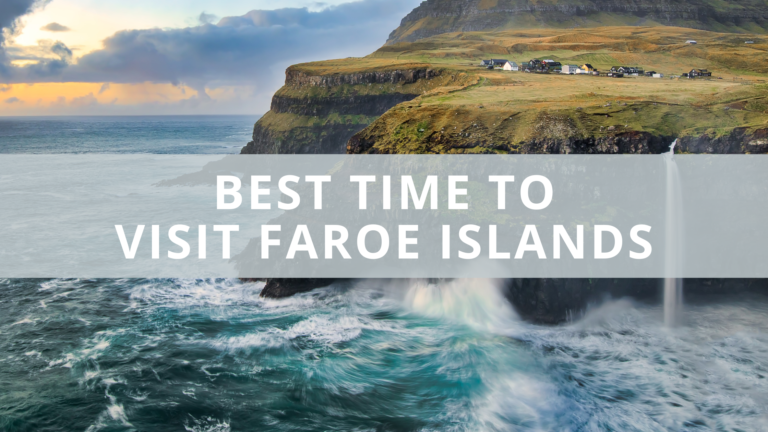When Is the Best Time to Visit Faroe Islands? Plus 7 Top Tips
As a content writer who loves to travel, I understand the importance of knowing the best time to visit a place. And when it comes to the Faroe Islands, a group of 18 volcanic islands located in the North Atlantic Ocean between Iceland and Norway, timing your visit can make a big difference.
In this article, I’ll provide you with all the information you need to plan your trip during the best time to visit Faroe Islands based on weather, events, crowds, and prices, as well as some top tips to make the most of your trip.
Overview of Faroe Islands
Before we dive into the specifics of when to visit, let’s start with a brief overview of the Faroe Islands. With a population of just over 50,000 people, the Faroe Islands are known for their rugged landscapes, dramatic cliffs, and picturesque villages. The islands are a paradise for nature lovers and outdoor enthusiasts, with opportunities for hiking, birdwatching, kayaking, and more.
Weather in the Faroe Islands
One of the biggest factors to consider when planning your trip to the Faroe Islands is the weather. The islands have a subpolar oceanic climate, which means that temperatures are mild throughout the year, but the weather can be unpredictable and changeable.
The summer months, from June to August, are the warmest and driest months, with average temperatures ranging from 10 to 14°C (50 to 57°F). The days are long, with up to 19 hours of daylight in June. However, it’s worth noting that even in the summer, the weather can be cloudy, windy, and rainy, so be sure to pack appropriate clothing.
If you prefer milder weather and smaller crowds, consider visiting in the shoulder seasons of May or September. These months offer a good compromise between decent weather and fewer visitors. Temperatures in May and September range from 7 to 11°C (45 to 52°F), and you’ll have a good chance of experiencing some sunny days.
Winter in the Faroe Islands, from December to February, can be harsh, with cold temperatures and strong winds. However, the scenery can be breathtaking, with snow-capped mountains and frozen waterfalls. If you’re a fan of winter sports, such as skiing or snowshoeing, this could be the perfect time to visit.
Events in the Faroe Islands
Another factor to consider when planning your trip to the Faroe Islands is the events calendar. The islands have a rich cultural heritage, and there are many festivals and events that take place throughout the year.
One of the biggest events is Ólavsøka, which takes place in late July or early August and celebrates the Faroe Islands’ national holiday. This festival includes a variety of cultural events, including traditional Faroese music, dance, and food.
If you’re a music lover, be sure to check out the G! Festival, which takes place in July and features international and local musicians performing in the stunning setting of Gøta Beach.
Other events to consider include the Faroe Islands International Documentary Film Festival in April, the Tórshavn Marathon in June, and the Faroe Islands Seafood Festival in August.
Crowds and Prices
Crowds and prices are also important factors to consider when planning your trip to the Faroe Islands. The high season for tourism is from June to August, when the weather is warmest and the days are longest. During this time, accommodation prices can be higher and popular attractions can be crowded. If you’re planning to visit during this time, be sure to book your accommodation and activities in advance.
In contrast, the shoulder seasons of May and September offer lower prices and fewer crowds. You’ll have a better chance of finding accommodation and activities at a more affordable price, and you’ll also have more space to enjoy the attractions without having to navigate large crowds.
Top Tips for Visiting the Faroe Islands
Now that we’ve covered the basics of the best time to visit Faroe Islands, let’s dive into some top tips to make the most of your trip.
- Rent a Car: The best way to explore the Faroe Islands is by car. Renting a car will give you the freedom to explore at your own pace and discover hidden gems that you might miss on a guided tour.
- Pack for All Weather: The weather in the Faroe Islands can be unpredictable, so it’s essential to pack for all eventualities. Bring waterproof and windproof clothing, as well as sturdy hiking shoes.
- Book Accommodation Early: If you’re planning to visit during the high season, it’s important to book your accommodation early to ensure that you get the best deals and availability.
- Try the Local Food: The Faroe Islands have a rich culinary tradition, with dishes such as fermented lamb and dried fish. Be sure to try some of the local specialties while you’re there.
- Respect the Environment: The Faroe Islands are a fragile ecosystem, and it’s important to respect the environment while you’re there. Stick to designated hiking trails, avoid littering, and be mindful of the wildlife.
- Take a Boat Trip: One of the best ways to appreciate the dramatic landscapes of the Faroe Islands is from the water. Take a boat trip around the islands to see the cliffs and waterfalls from a unique perspective.
- Learn Some Faroese: While English is widely spoken in the Faroe Islands, learning a few words of the local language, Faroese, can be a fun and engaging way to connect with the local culture.
Frequently Asked Questions
Here are some frequently asked questions related to “When is the best time to visit Faroe Islands?”:
What is the best time to visit the Faroe Islands for hiking?
The best time to visit for hiking is in the summer months, from June to August, when the weather is mildest and the days are longest.
Is it possible to see the Northern Lights in the Faroe Islands?
Yes, it’s possible to see the Northern Lights in the Faroe Islands, but the best time to see them is in the winter months, from December to February.
How do I get to the Faroe Islands?
The easiest way to get to the Faroe Islands is by plane. There are regular flights from Denmark, Iceland, Norway, and the United Kingdom.
Is the Faroe Islands expensive to visit?
The cost of visiting the Faroe Islands can vary depending on the time of year and your travel style. During the high season, prices can be higher, but there are ways to save money, such as visiting during the shoulder season and booking accommodation in advance.
Are there any safety concerns when visiting the Faroe Islands?
The Faroe Islands are generally a safe destination, but it’s important to be mindful of the weather and terrain when exploring the islands. Stick to designated hiking trails, be aware of your surroundings, and follow any local safety guidelines.
Conclusion to the Best Time to Visit Faroe Islands
The Faroe Islands are a unique and beautiful destination that offers something for everyone, from rugged landscapes and outdoor activities to cultural events and local cuisine.
By considering the factors of weather, events, crowds, and prices, and following our top tips, you can plan the perfect trip to the Faroe Islands. So pack your bags, rent a car, and get ready to explore the stunning natural beauty and rich cultural heritage of this incredible archipelago.
Remember to pack for all weather conditions, book your accommodation early, and try some of the local food while you’re there. And don’t forget to respect the environment by sticking to designated hiking trails and being mindful of the wildlife.
Whether you’re interested in hiking, photography, or simply enjoying the stunning scenery, the Faroe Islands are a destination that should be on everyone’s bucket list. So what are you waiting for? Start planning your trip today!
- What to Wear in Cancun by Month & Activity (And Not!) - March 13, 2023
- What to Wear in New York by Month & Activity (And Not!) - March 13, 2023
- What to Wear in Morocco by Month & Activity (And Not!) - March 13, 2023

